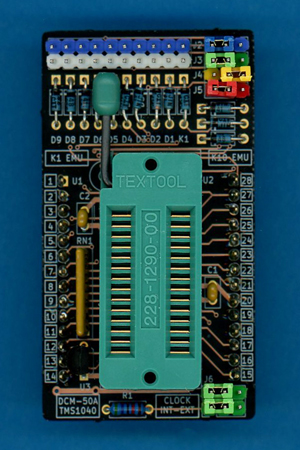
DATAMATH CALCULATOR MUSEUM
 |
DATAMATH CALCULATOR MUSEUM |
Datamath Calculator Museum DCM-50A TMS1040 Adapter
| Date of introduction: | September 21, 2022 | Display technology: | n.a. |
| New price: | Display size: | n.a. | |
| Size: | 2.6" x 1.5" x 1.00" 66 x 38 x 25 mm3 |
||
| Weight: | 1.0 ounces, 28 grams | Serial No: | 0001 |
| Batteries: | n.a. | Date of manufacture: | mth 12 year 2022 |
| AC-Adapter: | n.a. | Origin of manufacture: | USA |
| Precision: | Integrated circuits: | ZIF-Socket for TMS1040 (SPDIP) | |
| Memories: | |||
| Program steps: | Courtesy of: | Joerg Woerner |

![]() The
TMS1040 Product Family is based on the TMS1070 "computer-on-a-chip"
introduced in 1974 with the original
TMS1000.
While the TMS1070 can directly interface with low-voltage Vacuum Fluorescent
Displays (VFDs) up to 35 Volts
does it still need external resistors and a zener diode to bias the anodes and
grids of the display with respect to the filament. The
TMS1040 added an extra
VPP pin to connect a negative 30 Volts bias voltage for its modified
output drivers. With the TMS1070 featuring 11 R Outputs for the Digits, 8 O
Outputs for the Segments and 4 K Inputs for the Keyboard, reduced the TMS1040
the number of R Outputs to 9, consequently are all known TMS1040 calculator
designs using a 9-digit VFD.
The
TMS1040 Product Family is based on the TMS1070 "computer-on-a-chip"
introduced in 1974 with the original
TMS1000.
While the TMS1070 can directly interface with low-voltage Vacuum Fluorescent
Displays (VFDs) up to 35 Volts
does it still need external resistors and a zener diode to bias the anodes and
grids of the display with respect to the filament. The
TMS1040 added an extra
VPP pin to connect a negative 30 Volts bias voltage for its modified
output drivers. With the TMS1070 featuring 11 R Outputs for the Digits, 8 O
Outputs for the Segments and 4 K Inputs for the Keyboard, reduced the TMS1040
the number of R Outputs to 9, consequently are all known TMS1040 calculator
designs using a 9-digit VFD.
Texas Instruments started to add with the TMS1040 a "virtual" 5th Keyboard Input line by using two additional diodes emulating the 5 K Inputs of the TMC0980 Family. While the TMS0100 single-chip calculator circuit introduced the concept of an 11x4 keyboard matrix scanned with the 11 Digit Outputs and 4 Keyboard Inputs, would the reduction to just 9 Digit Outputs of the TMS1040 allow for only 9x4 keys and switches, in some calculator applications a possible show-stopper. Adding an extra "virtual" Keyboard Input allows consequently for a 9x5 keyboard matrix supporting up to 45 contacts.
The Datamath Calculator Museum DCM-50A Platform offers a lot of flexibility to access the features of calculators based on Texas Instruments’ single-chip calculator circuits but is centered around an 11x4 keyboard matrix and the TMS1000 ZIF-Socket doesn't support the additional VPP bias voltage used with the TMS1040 design. All known calculator designs using the "virtual" 5th Keyboard Input line are connecting slide switches or jumper diodes between the 9 R Outputs and the K1 Input.
One additional feature of the TMS1040 compared to other members of the TMS1000 Family is the integration of a small capacitor for the Clock Oscillator allowing for some extra cost savings of the products.
To access all features of a calculator based on the TMS1040 Product Family, the schematics and layout of the TMS1040 Adapter are providing accordingly:
| • Local voltage regulator to generate VDD
(-9V) of TMS1040 • Routing VDD from TMS1000 to VPP (-15V) of TMS1040 • Optional "Virtual" K10 Keyboard Input by connecting "Physical" K1 Keyboard Input with Diodes to any of K2, K4, or K8 Inputs of TMS1040 • Optional "Slide Switches / Diode Jumper" Keyboard Inputs connected to K1 Input of TMS1040 while using "Virtual" K10 Input of TMS1040 • 68k Ohm Resistor to calibrate the integrated Clock Oscillator |
Please notice that the TMS1040 Adapter needs to be plugged into the rightmost TMS1000 Pin-Headers on the DCM-50A Platform.
If you have additions to the above article please email: joerg@datamath.org.
© Joerg Woerner, January 5, 2023. No reprints without written permission.